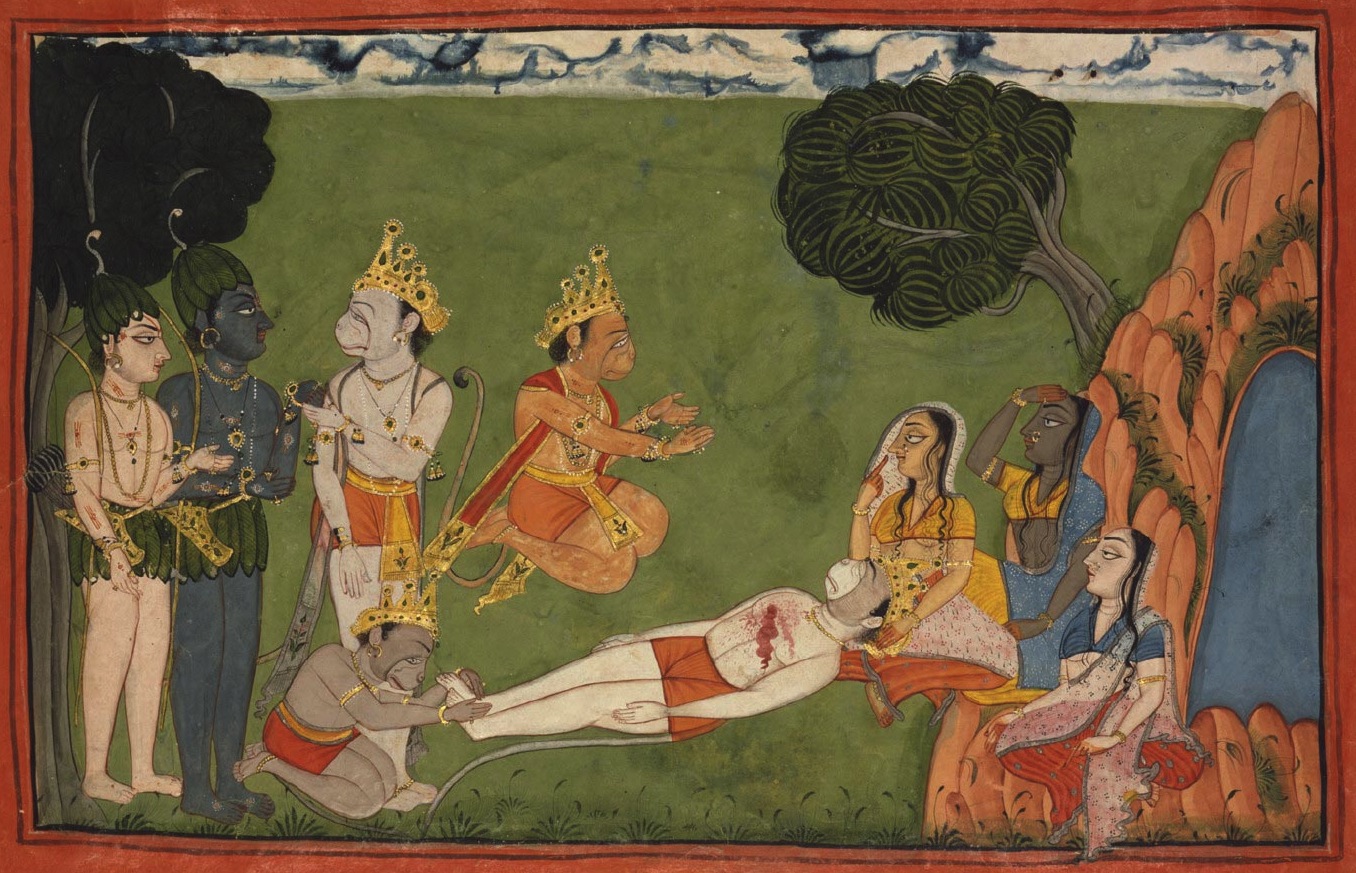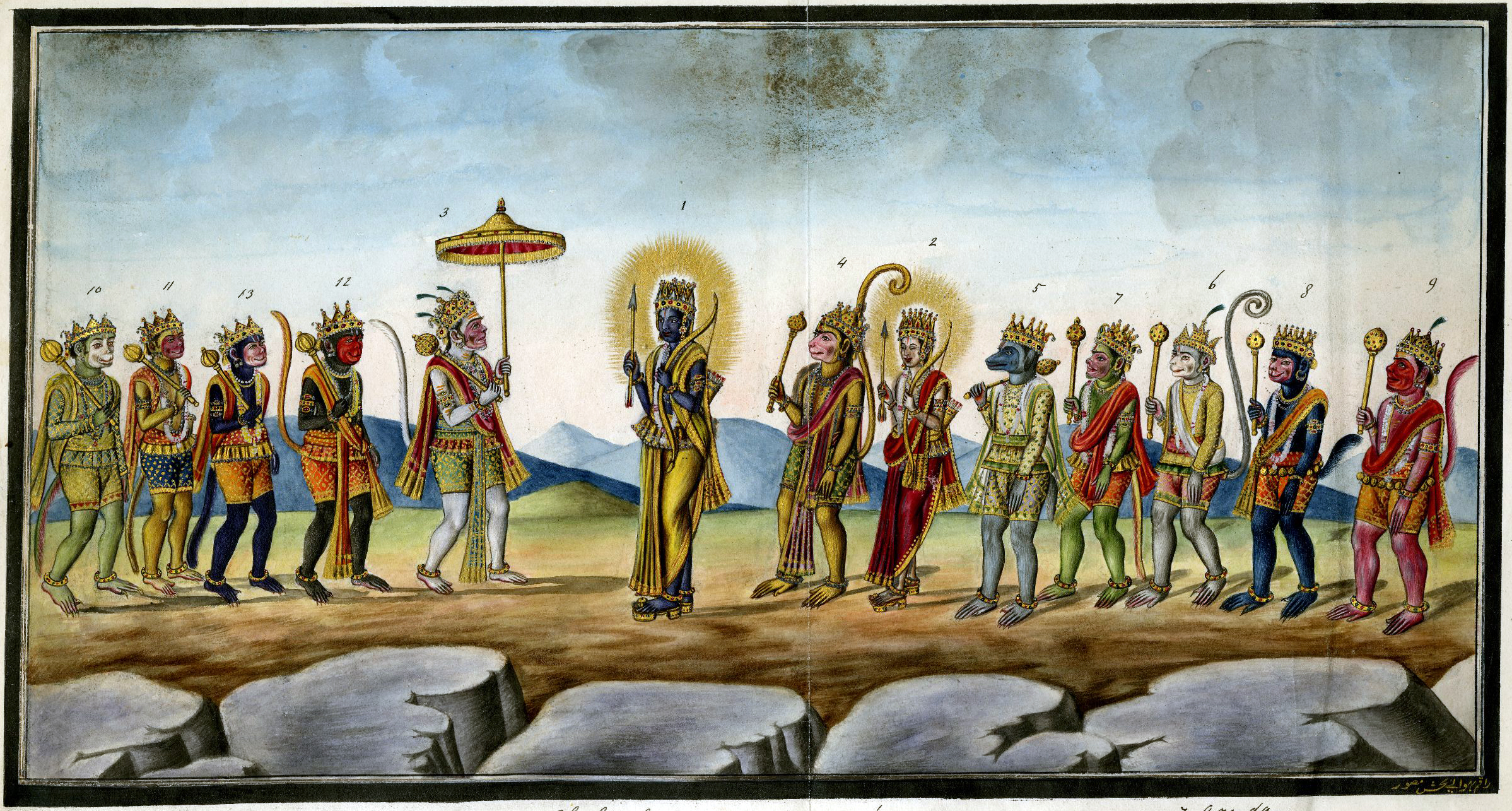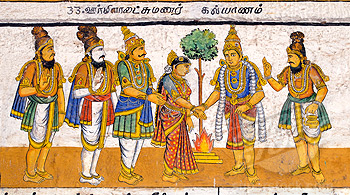|
Tara (Ramayana)
In the Hindu epic ''Ramayana'', Tara (, , ) is the Queen of Kishkindha and the wife of the vanara (monkey) King Vali (Ramayana), Vali. After being widowed, she becomes the Queen of Sugriva, Vali's younger brother. Tara is described as the daughter of the vanara physician Sushena in the ''Ramayana'', and in later sources, as an ''apsara'' (celestial nymph) who rises from the Samudra manthan, churning of the milky ocean. She marries Vali and bears him a son named Angada. After Vali is presumed dead in a battle with a demon, his brother Sugriva becomes king and appropriates Tara; however, Vali returns and regains Tara and exiles his brother, accusing him of treachery. When Sugriva challenges Vali to a duel, Tara wisely advises Vali not to accept because of the former's alliance with Rama—the hero of the ''Ramayana'' and an avatar of the god Vishnu—but Vali does not heed her, and dies from Rama's arrow, shot at the behest of Sugriva. The ''Ramayana'' and its later adaptations e ... [...More Info...] [...Related Items...] OR: [Wikipedia] [Google] [Baidu] |
Vanara
In Hinduism, Vanara () are either monkeys, apes, or a race of forest-dwelling people. In the epic the ''Ramayana'', the Vanaras help Rama defeat Ravana. They are generally depicted as humanoid apes, or human-like beings. Etymology There are three main theories about the etymology of the word "Vanara": * Aiyanar suggests that ''vanara'' means "monkey" derived from the word ''vana'' ("forest"), Literally meaning "belonging to the forest" Monier-Williams says it is probably derived from ''vanar'' (lit. "wandering in the forest") and means "forest-animal" or monkey. * Devdutt Pattanaik suggests that it derives from the words ''vana'' ("forest"), and ''nara'' ("man"), thus meaning "forest man" and suggests that they may not be monkeys, which is the general meaning. * It may be derived from the words ''vav'' and ''nara'', meaning "is it a man?" (meaning "monkey") or "perhaps he is man". Identification Although the word Vanara has come to mean "monkey" over the years and th ... [...More Info...] [...Related Items...] OR: [Wikipedia] [Google] [Baidu] |
Lakshmana
Lakshmana (, ), also known as Laxmana, Lakhan, Saumitra, and Ramanuja, is the younger brother of Rama in the Hindu epic ''Ramayana''. He is considered as an incarnation of Shesha, the lord of serpents. Lakshmana was married to Urmila, and is known for his loyalty and dedication towards Rama. Lakshmana was born to King Dasharatha of Ayodhya and Queen Sumitra. Shatrughna, is his twin brother. He was married to Urmila, after his brother Rama married Sita in her swayamvara. Lakshmana devoted himself to Rama since childhood and accompanied him during his fourteen-year exile, serving him and Sita endlessly. He also played a pivotal role in the war and killed Meghanada. Lakshmana is worshipped in Hinduism, at various places in India, alongside Rama and Sita. Etymology The name Lakshmana is of Sanskrit origin, which means 'the one endowed with auspicious signs'. He bears the epithets of Saumitra (, ) and Ramanuja (, ). Legend Birth and early life King Dasharatha of A ... [...More Info...] [...Related Items...] OR: [Wikipedia] [Google] [Baidu] |
Amrita
''Amrita'' (, IAST: ''amṛta''), ''Amrit'' or ''Amata'' in Pali language, Pali, (also called ''Sudha'', ''Amiy'', ''Ami'') is a Sanskrit word that means "immortality". It is a central concept within Indian religions and is often referred to in ancient Indian texts as an Elixir of life, elixir. Its first occurrence is in the Rigveda, where it is considered one of several synonyms for ''soma (drink), soma'', the drink of the Deva (Hinduism), devas. Amrita plays a significant role in the Samudra manthan, Samudra Manthana, and is the cause of the conflict between devas and asuras competing for amrita to obtain immortality. Amrita has varying significance in different Indian religions. The word ''Amrit'' is also a common first name for Sikhs and Hindus, while its feminine form is ''Amritā''. Amrita is cognate to and shares many similarities with ambrosia; both originated from a common Proto-Indo-European mythology, Proto-Indo-European source."Ambrosia" in ''Chambers's Encyclopædi ... [...More Info...] [...Related Items...] OR: [Wikipedia] [Google] [Baidu] |
Ocean Of Milk
In Hindu cosmology, the ''Kshira Sagara'' (, ; ; ; Telugu: Pala Samudram) or Ocean of Milk is the fifth from the centre of the seven oceans. It surrounds the continent known as Krauncha. According to Hindu scriptures, the devas and asuras worked together for a millennium to churn this ocean in order to acquire amrita, the nectar of immortality. The episode is mentioned in the ''Samudra Manthana'' chapter of the Puranas, a body of ancient Hindu legends. The Kshira Sagara is described as the place where the deity Vishnu reclines over his serpent-mount Shesha, accompanied by his consort, Lakshmi. Etymology The "Ocean of Milk" is the English translation of the Sanskrit terms ', ' or ', from '' kṣīra'' "milk" and ', ' "water, ocean" or ' "ocean." The term varies across Indic languages, referred to as ''Khir Shaagor'' in Bengali, ''Tiruppāṟkaṭal'' in Tamil, and ''Pāla Samudram'' in Telugu. The Churning of the Ocean The Kshira Sagara is the site of the legend of the Sam ... [...More Info...] [...Related Items...] OR: [Wikipedia] [Google] [Baidu] |
Rumā
Rumā () is a vanara also known as Tara and as the queen of Kishkindha mentioned in the epic ''Ramayana''. She is the wife of King Sugrīva, who ruled over the vanara kingdom of Kishkindha. Legend Ruma is mentioned in Book IV (Kishkindha Kanda) of Ramayana. Sugriva fell in love with her. But Ruma's father did not approve. Hence, Sugriva with the help of Hanuman, abducted Ruma and they married each other. Ruma was taken away from Sugriva by Vāli following the strife of two royal Vānara brothers. Later, the fact of Rumā being withheld by Vāli became the primary justification for Rama Rama (; , , ) is a major deity in Hinduism. He is worshipped as the seventh and one of the most popular avatars of Vishnu. In Rama-centric Hindu traditions, he is considered the Supreme Being. Also considered as the ideal man (''maryāda' ...'s slaying Vāli and helping Sugrīva to become the sovereign of Kishkindha. When accused by Vāli of lowly, treacherous, and unexpected a ... [...More Info...] [...Related Items...] OR: [Wikipedia] [Google] [Baidu] |
Ranganatha Ramayanam
''Sri Ranganatha Ramayanamu'' (Telugu: శ్రీ రంగనాథ రామాయణము) is a rendition of Valmiki's '' Rāmāyaṇa'' in Telugu language. It was written by the poet Ranganatha—also known as Gona Budda Reddy—between 1300 and 1310 CE. It was composed in 17,290 couplets (in Dwipada metre). This metre is lyrical and can either be recited like the Valmiki ''Ramayana'' (written in Anustupa metre) or sung like the ''Ramcharitmanas'' (written in Doha- Chaupai). Telugu has a very rich literary tradition, starting in the 11th century CE. Although there are more than forty adaptions of the Valmiki ''Ramayana'' which are partly or completely in Telugu, only four adaptions have covered the entire theme of the original epic. They are ''Ranganatha Ramayanam'', ''Bhaskara Ramayanam'', ''Molla Ramayanam'', and '' Ramayana Kalpavruksham''. Structure and Manthara's Antagonism towards Rama. Although Ranganatha follows the theme of the Valmiki ''Ramayana'', he still made ... [...More Info...] [...Related Items...] OR: [Wikipedia] [Google] [Baidu] |
Telugu Language
Telugu (; , ) is a Dravidian languages, Dravidian language native to the Indian states of Andhra Pradesh and Telangana, where it is also the official language. Spoken by about 96 million people (2022), Telugu is the most widely spoken member of the Dravidian language family, and one of the twenty-two Languages with legal status in India, scheduled languages of the Republic of India. It is one of the few languages that has primary official status in more than one States and union territories of India, Indian state, alongside Hindi and Bengali language, Bengali. Telugu is one of the languages designated as a Classical Languages of India, classical language by the Government of India. It is the 14th most spoken native language in the world.Statistics in Modern Standard Telugu is based on the dialect of erstwhile Krishna, Guntur, East Godavari and ... [...More Info...] [...Related Items...] OR: [Wikipedia] [Google] [Baidu] |
Ramavataram
The ''Ramavataram'', popularly referred to as ''Kamba Ramayanam'', is a Tamil epic that was written by the Tamil poet Kambar during the 12th century. Based on Valmiki's ''Ramayana'' (which is in Sanskrit), the story describes the legend of King Rama of Ayodhya. However, the ''Ramavataram'' is different from the Sanskrit version in many aspects – both in spiritual concepts and in the specifics of the storyline. This historic work is considered by both Tamil scholars and the general public as one of the greatest literary works in Tamil literature. Kambar wrote this epic with the patronage of Thiruvennai Nallur Sadayappa Vallal, a chieftain of the Pannai lineage. In gratitude to his patron, Kamban references his name once in every 1,000 verses. Early references in Tamil literature Even before Kambar wrote the Ramavataram in Tamil in the 12 century CE, there are many ancient references to the story of Ramayana, implying that the story was familiar in the Tamil lands e ... [...More Info...] [...Related Items...] OR: [Wikipedia] [Google] [Baidu] |
Tamil Language
Tamil (, , , also written as ''Tamizhil'' according to linguistic pronunciation) is a Dravidian language natively spoken by the Tamil people of South Asia. It is one of the longest-surviving classical languages in the world,. "Tamil is one of the two longest-surviving classical languages in India" (p. 7). attested since 300 BC, 300 BCE.: "...the most acceptable periodisation which has so far been suggested for the development of Tamil writing seems to me to be that of A Chidambaranatha Chettiar (1907–1967): 1. Sangam Literature – 200BC to AD 200; 2. Post Sangam literature – AD 200 – AD 600; 3. Early Medieval literature – AD 600 to AD 1200; 4. Later Medieval literature – AD 1200 to AD 1800; 5. Pre-Modern literature – AD 1800 to 1900" at p. 610 Tamil was the lingua franca for early maritime traders in South India, with Tamil inscriptions found outside of the Indian subcontinent, such as Indonesia, Thailand, and Egypt. The language has a well-documented history wit ... [...More Info...] [...Related Items...] OR: [Wikipedia] [Google] [Baidu] |
Brihaspati
Brihaspati (, ), is a Hindu god. In the ancient Vedic scriptures, Brihaspati is associated with fire, and the word also refers to a god who counsels the devas and devis (gods and goddesses). In some later texts, the word refers to the largest planet of the Solar System, Jupiter, and the deity is associated with the planet as a Navagraha. Sage Brihaspati appears in the Rigveda (pre-1000 BCE), such as in the dedications to him in the hymn 50 of Book 4; he is described as a sage born from the first great light, the one who drove away darkness, is bright and pure, and carries a special bow whose string is '' Rta'' or "cosmic order" (basis of dharma). His knowledge and character is revered, and he is considered Guru (teacher) by all the Devas. In the Vedic literature and other ancient texts, sage Brihaspati is also called by other names such as Bramanaspati, Purohita, Angirasa (son of Angiras) and Vyasa; he is sometimes identified with god Agni (fire). His wife is Tara (or g ... [...More Info...] [...Related Items...] OR: [Wikipedia] [Google] [Baidu] |
Surya
Surya ( ; , ) is the Sun#Dalal, Dalal, p. 399 as well as the solar deity in Hinduism. He is traditionally one of the major five deities in the Smarta tradition, Smarta tradition, all of whom are considered as equivalent deities in the Panchayatana puja and a means to realise Brahman. Other names of Surya in ancient Indian literature include Āditya, Arka, Bhānu, Savitṛ, Pūṣan, Ravi, Mārtāṇḍa, Mitra, Bhāskara, Prabhākara, Kathiravan, and Vivasvat.#Dalal, Dalal, pp. 5, 311 The iconography of Surya is often depicted riding a chariot harnessed by horses, often seven in number which represent the seven colours of visible light, and the seven days of the week. During the medieval period, Surya was worshipped in tandem with Brahma during the day, Shiva at noon, and Vishnu in the evening. In some ancient texts and art, Surya is presented syncretically with Indra, Ganesha, and others. Surya as a deity is also found in the arts and literature of Buddhism and Jainism. Surya ... [...More Info...] [...Related Items...] OR: [Wikipedia] [Google] [Baidu] |
Indra
Indra (; ) is the Hindu god of weather, considered the king of the Deva (Hinduism), Devas and Svarga in Hinduism. He is associated with the sky, lightning, weather, thunder, storms, rains, river flows, and war. [3 volumes] Indra is the most frequently mentioned deity in the ''Rigveda''. He is celebrated for his powers based on his status as a god of order, and as the one who killed the great evil, an Asura (Hinduism), asura named Vritra, who obstructed human prosperity and happiness. Indra destroys Vritra and his "deceiving forces", and thereby brings rain and sunshine as the saviour of mankind. Indra's significance diminishes in the post-Vedic Indian literature, but he still plays an important role in various mythological events. He is depicted as a powerful hero. According to the ''Vishnu Purana'', Indra is the title borne by the king of the gods, which changes every Manvantara – a cyclic period of time in Hindu cosmology. Each Manvantara has its own Indra and the In ... [...More Info...] [...Related Items...] OR: [Wikipedia] [Google] [Baidu] |






